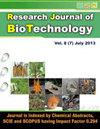Cultivation, Phytochemical screening and Antimicrobial analysis of caterpillar mushroom Cordyceps militaris and fruiting body
IF 0.2
Q4 Biochemistry, Genetics and Molecular Biology
引用次数: 0
Abstract
The fungus Cordyceps militaris comes under the family cordyciptiaceae and class ascomycetes. In ancient time it was used in Chinese and Tibetan medicines for lungs and kidney diseases but with the change in era, more researches were conducted on it. This study was designed for the cultivation of Cordyceps militaris (C.M.) mushroom on brown rice media as the measure component and evaluation of its quantitative, qualitative and free radical scavenging activity of the methanolic extract. To know the bioactive compounds, preliminary phytochemical analysis was done which states that methanolic extract of Cordyceps contains protein, phenol, alkaloids, tannin, flavonoids, coumarins, polysaccharides and carbohydrates. The quantitative analysis of methanolic extract was quantified using determination of total phenol and total flavonoids using Folin-Ciocalteu reagent and Aluminium calorimetric assay method respectively. Phyto- compounds were depicted through Fourier transform infrared spectroscopy (FTIR) and Gas chromatography- mass spectroscopy (GC-MS) while the free radical scavenging activity was determined using the 1,1-diphenyl-2-pycryl-hydrazyl (DPPH) assay, hydrogen peroxide assay, ferric reducing antioxidant power (FRAP) assay and reducing power assay. Highest phenolic and flavonoid contents were depicted in CM100%meth while CM100%meth. showed highest free radical scavenging activity. The assessment of extract for antimicrobial activity was done with well diffusion method against Gram positive and Gram negative bacteria revealing that aqueous and methanolic extract are more effective against Bacillus subtilis and Escherichia coli.虫草菌及子实体的栽培、植物化学筛选和抗菌分析
冬虫夏草菌属冬虫夏草科、子囊菌属。在古代,冬虫夏草是治疗肺病和肾病的中药和藏药,但随着时代的变迁,人们对其进行了更多的研究。本研究旨在以糙米为培养基栽培冬虫夏草(Cordyceps militaris (C.M.)),并评估其甲醇提取物的定量、定性和清除自由基活性。为了了解冬虫夏草的生物活性化合物,研究人员进行了初步的植物化学分析,结果表明冬虫夏草的甲醇提取物含有蛋白质、酚类、生物碱、单宁、黄酮类、香豆素、多糖和碳水化合物。采用 Folin-Ciocalteu 试剂和铝热法分别测定了总酚和总黄酮,对甲醇提取物进行了定量分析。植物化合物通过傅立叶变换红外光谱法(FTIR)和气相色谱-质谱法(GC-MS)进行描述,自由基清除活性则通过 1,1-二苯基-2-吡啶-肼(DPPH)检测法、过氧化氢检测法、铁还原抗氧化力(FRAP)检测法和还原力检测法进行测定。CM100%meth 的酚和类黄酮含量最高,而 CM100%meth 的自由基清除活性最高。采用井扩散法对革兰氏阳性菌和革兰氏阴性菌进行了提取物抗菌活性评估,结果表明水提取物和甲醇提取物对枯草杆菌和大肠杆菌更有效。
本文章由计算机程序翻译,如有差异,请以英文原文为准。
求助全文
约1分钟内获得全文
求助全文
来源期刊

Research Journal of Biotechnology
工程技术-生物工程与应用微生物
CiteScore
0.60
自引率
0.00%
发文量
192
审稿时长
1.5 months
期刊介绍:
We invite you to contribute Research Papers / Short Communications / Review Papers:
-In any field of Biotechnology, Biochemistry, Microbiology and Industrial Microbiology, Soil Technology, Agriculture Biotechnology.
-in any field related to Food Biotechnology, Nutrition Biotechnology, Genetic Engineering and Commercial Biotechnology.
-in any field of Biotechnology related to Drugs and Pharmaceutical products for human beings, animals and plants.
-in any field related to Environmental Biotechnolgy, Waste Treatment of Liquids, Soilds and Gases; Sustainability.
-in inter-realted field of Chemical Sciences, Biological Sciences, Environmental Sciences and Life Sciences.
-in any field related to Biotechnological Engineering, Industrial Biotechnology and Instrumentation.
-in any field related to Nano-technology.
-in any field related to Plant Biotechnology.
 求助内容:
求助内容: 应助结果提醒方式:
应助结果提醒方式:


